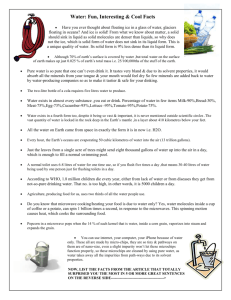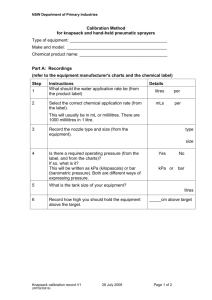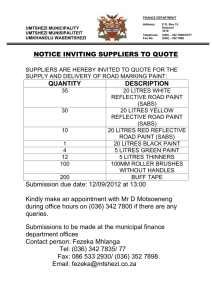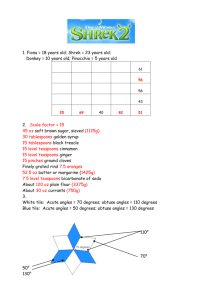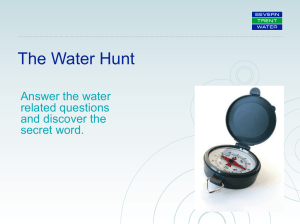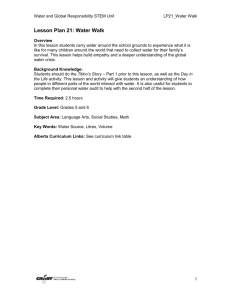lecture 17
advertisement
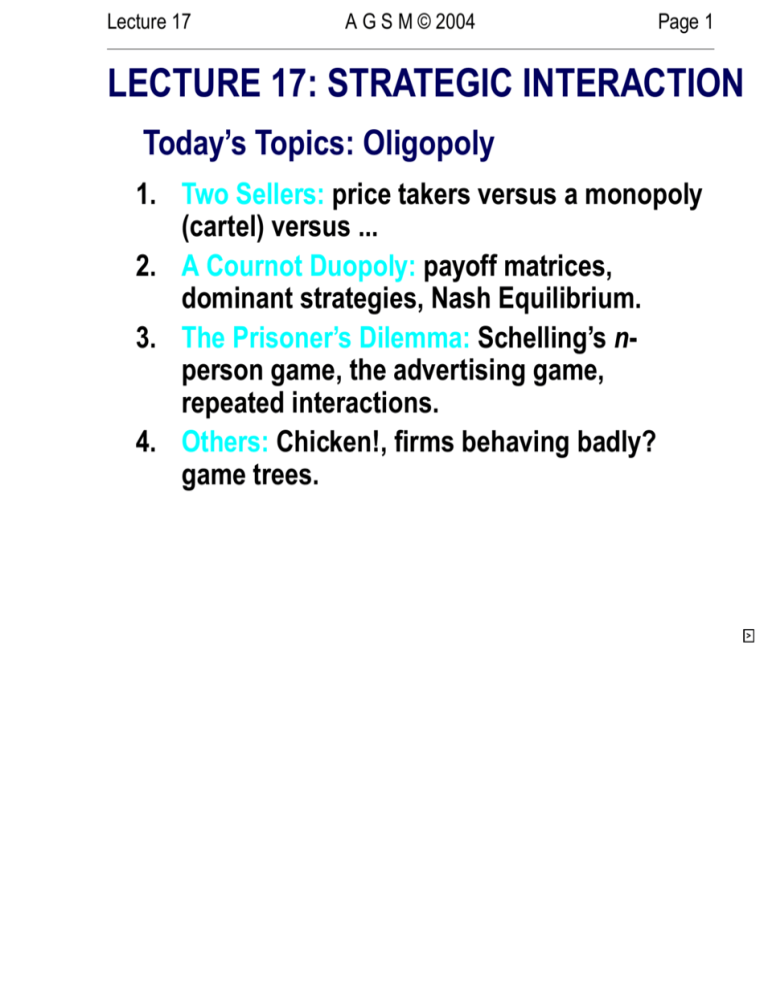
Lecture 17 A G S M © 2004 Page 1 LECTURE 17: STRATEGIC INTERACTION Today’s Topics: Oligopoly 1. 2. 3. 4. Two Sellers: price takers versus a monopoly (cartel) versus ... A Cournot Duopoly: payoff matrices, dominant strategies, Nash Equilibrium. The Prisoner’s Dilemma: Schelling’s nperson game, the advertising game, repeated interactions. Others: Chicken!, firms behaving badly? game trees. > Lecture 17 A G S M © 2004 Page 2 1. TWO SELLERS Sellers Jack and Jill face this market: Quantity Price Total Marginal Price Elasticity (litres/week) ($/litre) Revenue Revenue |η| Q P TR MR ($/l) (arc) (equation) 0 120 0 ∞ 110 23.0 10 110 1100 11.0 90 7.0 20 100 2000 5.0 70 3.8 30 90 2700 3.0 50 2.4 40 80 3200 2.0 30 1.67 50 70 3500 1.4 10 1.18 60 60 3600 1.0 −10 0.85 70 50 3500 0.71 −30 0.6 80 40 3200 0.5 −50 0.412 90 30 2700 0.333 −70 0.263 100 20 2000 0.2 −90 0.143 110 10 1100 0.091 −110 0.043 120 0 0 0 Note: TR is a maximum when MR = 0; for arc, see Lecture 4, pp 9,10; for equation, see Lecture 4, pp 12,13. < > Lecture 17 A G S M © 2004 Page 3 MORE OR LESS Assume that MC = 0 for all firm output y . Competition (price-taking): choose output y C to set Price P C = MC = 0 y C : MC (y C ) = 0 = P C ∴ Q C = 120 litres/week, π C = 0 × 120 = 0. Monopoly: choose output y M to set MR = MC = 0. y M : MR ((yy M ) = MC ((yy M ) = 0 ∴ Q M = 60 litres/week, P M = $60/litre, and π M = 60 × $60 = $3600/week < > Lecture 17 A G S M © 2004 Page 4 GRAPHICALLY 120 $/litre 90 Demand or AR M • 60 MR 30 0 0 CD • C • 30 60 90 Output Q /week 120 Competitive: P C = $0, Q C = 120. Monopoly: P M = $60, Q M = 60. Cournot duopoly: P CD = $40, Q CD = 80. < > Lecture 17 A G S M © 2004 Page 5 A CARTEL What if J & J get together and agree on either the quantity to sell or the price at which to sell it? → Collusion. A group of sellers (or buyers) acting together forms a Cartel. The two would act as a monopolist: selling 60 litres at $60/litre. How to split production and profits between them? If equally, then each produces 30 litres and makes $1800/week. < > Lecture 17 A G S M © 2004 Page 6 2. A COURNOT DUOPOLY If Jack assumes that Jill will produce 30 litres, what might he do? — Produce 30 litres and make $1800/week, or — Produce 40 litres and make ... what? Q = 30 + 40 = 70 litres → P = $50/litre. Jack’s profit = 40 × $50 = $2000 > $1800/week. Looks good. At 30 litres, Jill’s profit falls to 30 × 50 = $1500/week. But if Jill thinks like Jack, then Q = 40 + 40 = 80 → P = $40, and the profit of each = $1600/week. < > Lecture 17 A G S M © 2004 Page 7 PAYOFF MATRIX 1 Each player has two actions to choose from: produce 30 litres or produce 40 litres. Their decisions are made independently: model with a 2 × 2 matrix, where Jack chooses which Row and Jill chooses which Column. 40 Jill 30 40 1600, 1600 2000, 1500 30 1500, 2000 1800, 1800 Jack The payoff matrix (Jack, Jill). What will Jack do? What will Jill do? < > Lecture 17 A G S M © 2004 Page 8 DOMINANT STRATEGIES The chosen actions are 40,40, because each of Jack and Jill will choose to produce 40 litres, not 30. Choosing 40 over 30 is a dominant strategy for each player, since whatever the other seller does you’re better off by choosing 40 over 30 litres. But this is frustrating: if they could collude or cooperate, they’d make $1800 each, instead of $1600. What is best collectively is not attainable individually. This is an example of the Prisoner’s Dilemma. < > Lecture 17 A G S M © 2004 Page 9 NASH EQUILIBRIUM Would Jack produce still more? Say 50 litres/week? If Q = 40 + 50 = 90 litres, then P = $30, and Jack’s profit would be 50 × $30 = $1500 < $1600, so Jack has no incentive to produce more than 40 litres/week. Indeed, if both produce at 50 litres, each makes only $1000. y Jack = y Jill = 40 litres is a Nash Equilibrium: a situation in which each actor chooses her best strategy, given that the others have chosen their best strategies. < > Lecture 17 A G S M © 2004 Page 10 PAYOFF MATRIX 2 50 Jill 40 50 1000, 1000 1500, 1200 40 1200, 1500 1600, 1600 Jack The Nash Equilibrium at quantities (40,40) (and P = $40/litre) is shown by the arrows: any cell with no arrows leaving and only arrows into it is a Nash Equilibrium, There may be one, several, or no Nash Equilibria. This is not a Prisoner’s Dilemma. Why? Because what is best individually is also best if they acted together. < > Lecture 17 A G S M © 2004 Page 11 COMPARISONS So the duopolists produce at a rate (80 litres/week) less than competitive (120) but greater than monopolistic (60), at a price ($40/litre) greater than competitive ($0), but lower than monopolistic ($60). Their total profits ($3200/week) are less than monopolistic ($3600), but greater than competitive ($0). A Cournot duopoly because the firms set the quantity, and the market (demand) determines the price; in a Bertrand duopoly the firms set the price and the market determines the quantity. < > Lecture 17 A G S M © 2004 Page 12 3. THE PRISONER’S DILEMMA Let’s play Tom Schelling’s Game Rules: ➣ Single play, $4 to play: by writing your name on the slip ➣ Vote “C” (Coöperate) or “D” (Defect). ➣ Sign your ballot (and commit to pay the entry fee). ➣ If x% vote “C” and (100 − x)% vote “D”: • then “C”s’ net payoff = x 100 × $6 − $4 • and “D”s’ net payoff = “C” payoff + $2 ➣ Or: You needn’t play at all. < > Lecture 17 A G S M © 2004 Page 13 $ gross payout per participant SCHELLING’S GAME 2 8 “D” 6 “C” 4 2 0 0 25 50 75 100 Percentage of participants voting C Note: the game costs $4 to join. < > Lecture 17 A G S M © 2004 Page 14 SCHELLING’S GAME 3 What happened? ➣ numbers and payoffs. ➣ previous years? coöperate for the common good or Dilemma: defect for oneself Public/private information < > Lecture 17 A G S M © 2004 Page 15 SCHELLING’S n-PERSON PD Examples? — — — — — — — cooperative pricing v. price wars tax compliance individual negotiation coal exports market development common property issues others? < > Lecture 17 A G S M © 2004 Page 16 THE PRISONER’S DILEMMA Spill Kelly Mum Spill 8, 8 0, 20 Mum 20, 0 1, 1 Ned Years of prison (Ned, Kelly). The choices: Spill the beans to the cops, or keep Mum. Nash Equilibrium = Spill, Spill, despite the longer sentences. See also the Tragedy of the Commons in the Marks on-line reading. < > Lecture 17 A G S M © 2004 Page 17 THE ADVERTISING PD B&H Don’t Advertise Don’t Advertise Philip Morris Advertise Advertise $4bn, $4bn $2bn, $5bn $5bn, $2bn $3bn, $3bn Profits (Philip Morris, Benson & Hedges). N.E. at Advertise, Advertise, despite the lower profits. When tobacco advertising was banned on TV, tobacco firms’ profits rose. < > Lecture 17 A G S M © 2004 Page 18 BUT PEOPLE DO COOPERATE Why? The game is usually not played once, but many times. Jack and Jill, the Cournot duopolists, have no incentive not to cheat on their quotas of 30 litres, if they only play once. But if each knows that they will interact every week, and that a single defection (to 40 litres) would result in an eternity of 40 litres (forever forgoing the extra $200/week profit), this threat might support cooperation (30 litres/week). In a repeated PD, so long as the discount rate is not too high, repetition will support cooperation. < > Lecture 17 A G S M © 2004 Page 19 4. CHICKEN! The notorious game of Chicken!, as played by young men in fast cars. Here “Bomber” and “Alien” are matched. Veer Bomber Straight Veer Blah, Blah Chicken!, Winner Straight Winner, Chicken! Death? Death? Alien No dominant strategies: what’s best for one depends on the other’s action. N.E. where? Regrets? < > Lecture 17 A G S M © 2004 Page 20 FIRMS BEHAVING BADLY? Laws can hinder competition, as well as help it. Behaviour that seems to reduce competition may be legitimate. Price-fixing Resale price maintenance Predatory pricing Tying or bundling < > Lecture 17 A G S M © 2004 Page 21 A SEQUENTIAL GAME What if one player moves first? Use a game tree, in which the players, their actions, what they know (their information), and the timing of their actions are explicit. Raises the possibility of First-Mover Advantage, or Second-Mover Advantage, and Threats and Promises, and Credibility, and Incomplete Information, and Screening and Signalling. See Strategic Game Theory for Managers in Term 3. < > Lecture 17 A G S M © 2004 Page 22 BOEING v. AIRBUS Airbus and Boeing will develop a new commercial jet aircraft. Boeing is ahead in development, and Airbus is considering whether to enter the market. If Airbus stays out, it earns zero profit, while Boeing enjoys a monopoly and earns a profit of $1 billion. If Airbus enters, then Boeing has to decide whether to accommodate Airbus peacefully, or to wage a price war. With peace, each firm will make a profit of $300 m. With a price war, each will lose $100 m. < > Lecture 17 A G S M © 2004 Page 23 A GAME TREE Airbus Stay out✘ Enter Boeing Boeing Accept Airbus: 0 Boeing: $1bn $300m $300m ✘Fight −$100m −$100m How should Boeing respond? < > Lecture 17 A G S M © 2004 Page 24 ROLLBACK 1. 2. 3. 4. 5. 6. From the end (final payoffs), go up the tree to the first parent decision nodes. Identify the best decision for the deciding player at each node. “Prune” all branches from the decision node in 2. Put payoffs at new end = best decision’s payoffs Do higher decision nodes remain? If “no”, then finish. If “yes”, then go to step 1. For each player, the collection of best decisions at each decision node of that player → best strategies of that player. < > Lecture 17 A G S M © 2004 Page 25 QUESTIONS 1. Draw the tree for this game. Use rollback (or backwards induction) to find the equilibrium. 2. Why is Boeing unlikely to be happy about the equilibrium? What would it have preferred? Could it have made a credible threat to get Airbus to behave as it wanted? 3. What if Boeing had moved first? Would there still have been a credibility problem with Price War? Explain. < > Lecture 17 A G S M © 2004 Page 26 SUMMARY 1. 2. 3. 4. Oligopoly is a market structure between Perfect Competition and Monopoly, in which firms behave strategically. In a Cournot duopoly the two sellers of a homogeneous product choose quantities, and the market demand determines the price. Cooperation would lead to higher profits, but the logic of the once-off game is to cheat on agreed quotas → lower profits. Use Payoff Matrices for a simultaneousmove game and Game Trees for a sequentialmove game. < > Lecture 17 5. 6. 7. 8. A G S M © 2004 Page 27 Use arrows in the Payoff Matrix to determine whether and where the Nash Equilibrium (in which each player does the best for herself, given that the other players are doing the best for themelves) is. A dominant strategy is an action that is best for you, no matter what the other player does. The Prisoner’s Dilemma occurs when individual choices lead to a lower payoff than cooperative actions would. But repetition can overcome the once-off logic and result in cooperation. < > Lecture 17 A G S M © 2004 Page 28 9. Not all interactions have a single N.E. — some have none, some have several. 10. Can have 3×3 or larger payoff matrices. 11. Some market behaviours are illegal. 12. Rollback: look forward and reason back — to find the equilibrium of the game. < > Lecture 17 A G S M © 2004 Page 29 APPENDIX: CARTEL v. OLIGOPOLY The cartel chooses Q = y1 + y 2 to maximise its profit π = π (y1, y 2). When production shares are equal (y1 = y 2), then ∂π calculus ( ∂Q = 0) reveals that in this case with P = 120 − Q and zero costs y1* = y 2* = 30. Each oligopolist chooses its output y1 (or y 2 ) to maximise its profit π1 = π1(y1, y 2), but it has no control over the other firm’s output y 2 . Since the problem is symmetrical, assume y1 = y 2 , ∂π1 and calculus ( ∂y = 0) reveals that y1* = y 2* = 40. 1 <

